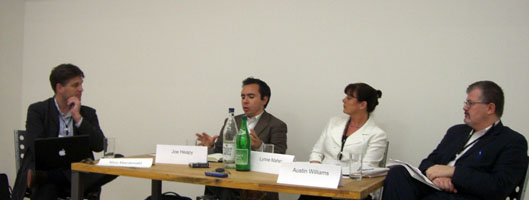Chair: Nico Macdonald
Joe Heapy (Engine), Lynne Maher (NHS Institute for Innovation and Improvement) & Austin Williams (Future Cities Project)
Inspired by Wikipedia and Linux, a new area of socially commited designers argue that products, and particulaly services, are best designed in collaboration with users and other stakeholders.
Is the open-source software model applicable to other areas of design? Is the primary aim to co-create high quality services, to shape behaviour, or encourage ‘social engagement’? If everyone can design, what is the the role of professional designers?

Post-panel discusson
Comments from attendees can be found on the Interactions thread: Can good design be ‘co-created’ post on the Intersections blog. If you attended the conference, please feel free to comment there yourself. if you write about a session in your own blog please ‘ping’ the TrackBack URL for the session post, so your post will also appear there for others to discover.
As well as the Report back (below), the podcasts are available on the School of Design site to download or stream, and the transcripts are available on the Design Council site. Read the transcript for this session. (The podcast may be low quality as the acoustics of the room in which the panel took place were poor.)
The following notes are based on the report back given to the conference by Nico Macdonald. They may be updated once the transcript has been published:
Intros
Joe: Good design can be co-created and could even be used to transform individuals and communities. The question is: How to enable other people to design stuff. The challenge for government is to move from solutions being design at the start of the process to solutions being designed through the process. Design is about agency.
Lynne: things have improved but we need better tools to get where we need to be. Past models could get good results (based on formal metrics), but did not create a good experience. (Example of a group of cancer patients re-designing and re-writing a patient-oriented leaflet.) Also, we don’’t listen to our own staff in re-designing services. Value of design methods: I am a trained clinical observer but I can’t see what designers see.
Austin:
- This is not the same as, for instance, tenant participation in the development of Byker Wall, which was kicking against state intervention. Today, designers are not being radical. Rather, designers are stooges of governemnt policy.
- New purpose? Yes, but not design. This is social policy or politics. Design is no longer talked about in its own terms [ie: it is prefixed with a term such as ‘co-design’.] This become self reinforcing, eg: good desgn is sustainable and sustainability is good design.
- Designers lost critical edge. Hiding behind the public. We are being encouraged to participate in generating positive outcomes. But what if I don’t want to take part?
What is co-creation?
It appears to be conflated between basic research and design techniques (such as ethnography, interview methods, etc) to participative or co-design and actual co-creation. Examples given included:
- Patients designing and writing communications
- Patients working with a designer to show how they would like information about their health to be presented
- Workshop with patients on the dessign of a waiting area [check] using Post-It notes
- Paritents working with a designer on the design of a Web site by blocking out its structure
Role of designers
Joe: People as an extra resource for lateral thinking and source of empathy [check]. Designers giving a sense of direction [check] and bringing quality. It is not the case that if someone draws something it has to be built. Take ideas to the point they are compelling.
Possibilites
[Audience]: [To Austin re his critique of institutional power] Co-creating as a way of circumventing the top down process, eg: in local government?
Dangers/Criticisms/Questions
[Audience]: Why is this a role for designers? Lynne: Designers given us tools and techniques. But designers are not runing the projects.
[Audience]: Did you employ designers to observe? If not, what is point training for design if you think you can pick up these techniques with so little training?
[Audience]: This phenomenon won’t last. Designers are the new, low cost management consultants... for now.
Austin: [On an approach described by Lynne to waiting room design] Over-egged/involved solutions... beware of the direct political repurcussions of these approaches.
Lynne: Risk of co-design becoming a catch phrase
Joe: Risk of co-design becoming a shiny new label for traditional public consultation. Purge yourself by working with real people. Also risk of getting into manipulating people’s behaviour, though not in our projects.
Lynne: Designers have a great opportunity to learn to talk to government

